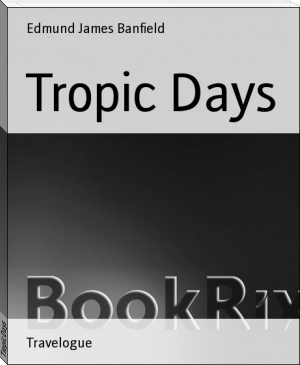Confessions of a Beachcomber by Edmund James Banfield (books to read to increase intelligence .TXT) 📖

- Author: Edmund James Banfield
Book online «Confessions of a Beachcomber by Edmund James Banfield (books to read to increase intelligence .TXT) 📖». Author Edmund James Banfield
The most remarkable if not the strangest denizens of the spot are two species of the big-eyed walking and climbing fish (PERIOPHTHALMUS KOELREUTERI and P. AUSTRALIS) which ascend the roots of the mangrove by the use of ventral and pectoral fins, jump and skip on the mud and over the surface of the water and into their burrows with rabbit-like alertness. They delight, too, in watery recesses under stones and hollows in sodden wood. Inquisitive and most observant they might be likened to Lilliputian seals, as they cling, a row of them, to a partially submerged root, and peer at you, ready to whisk away at the least sign of interference. They climb along the arching roots, the better to reconnoitre your movements and to outwit attempts at capture. Their eyes--in life, reflecting gems--are so placed that they command a complete radius, and if you think to sneak upon them they dive from their vantage points and skip with hasty flips and flops to another arching root, which they ascend, and resume their observation. It must not be assumed that the climbing fish--which seems to be more at home on the surface of the water than below--climbs up among the branches. A foot or so is about the limit of its upper wanderings.
Then, too, in what is generally regarded as a noisome, dismal, mangrove swamp, birds of cheerful and pleasing character congregate. Several honey-eaters, the little blue turtle dove, the barred-shouldered dove, the tranquil dove, the nutmeg pigeon, the little bittern, the grey sandpiper, the sordid kingfisher, the spotless egret, the blue heron, the ibis--all and others frequent such places, and in their season, butterflies come and go. In most of its aspects a mangrove swamp is not only the scene of one of Natures most vigorous and determined processes, but to those who look aright, a theatre of many wonders, a museum teeming with objects of interest, a natural aviary of gladsome birds.
THE UMBRELLA-TREE
Having paid, in passing, respects to the most gorgeous tree of the island, it would be sheer gracelessness to withhold a tribute to one of the commonest, though ever novel and remarkable--the umbrella-tree. Less conspicuous in its blooming than the flame-tree, it flourishes everywhere--on the beaches with its roots awash at high tide; on the rearguard of the mangroves, leaning on the white-flowered CALOPHYLLUMS; on the steep hill-sides; on the borders of the jungle, and gripping scorched rocks with naked roots.
While the flame-tree--few and confined to the beaches--flashes into bloom--an improvident blaze of colour, without a single atoning green leaf--the umbrella-tree charms for several months with a combination of graceful foliage and a unique corollary of singular flowers.
From the centre of whorls of shapely glossy leaves radiate simple racemes, 2 feet long, as thickly set with studs of dense heads of red flowers as Aaron's rod with its magical buds. Crowned with several crowns of varying numbers of rays, rarely as few as four, frequently seven and nine and occasionally as many as twelve, each tree is a distillery of nectar of crystal purity and inviting flavour. On every ray there may be eighty red studs, each composed of twelve compact flowers, and every flower drips limpid sweetness. For months this unexcised distillation never ceases. For all the birds and dainty butterflies and sober bees there is free abundance, and every puff of wind scatters the surplusage with spendthrift profusion. Sparkling in the sunbeams, dazzling white, red, orange, green, violet, the swelling drops tremble from the red studs and fall in fragrant splashes as the wanton wind brushes past or eager birds hastily alight on the swaying rays. A rare baptism to stand beneath the tree for the cool sweet spray to fall upon the upturned face, a baptism as pure as it is unceremonious.
Red-collared lorikeets revel in the nectar, hustling the noisy honey-eaters and the querulous sun-birds. The radiant blue butterfly sips and is gone, or if it be his intent to pause, tightly folds his wings on the instant of settling, and is transformed from a piece of living jewellery to a brown mottled leaf caught edgeways among the red flowers. The green and gold butterflies are for ever fluttering and quivering. The complaining lorikeets peevishly nudge them off with red, nectar-dripping bills, the honey-eaters disperse them with inconsiderate wing sweeps; but the butterflies are not to be denied their share. After a moment's airy flight they return to the feast, quivering with eagerness. And so the weeks pass, the patient tree generating food far beyond the daily needs of all who choose to take.
By a very moderate computation--such an orderly plan of bloom lends itself to simple statistics--the average production of a fairly crowned tree is over a gallon of nectar per day. Hundreds of trees so crowned brighten all parts of the island with their red rays. And where the nectar is, there will the sun-birds be gathered together--a sweeter notion, truly, than carcases and eagles.
And this nectar, clear as dew-drops, sweet with an aftertaste of some scented spice--a fragile pungency--was ever liqueur so purely compounded? Drawn from untainted soil; filtered and purified; passed from one delicate process to another, warmed during the day, cooled by night airs, chastened by breezes which have all the virtue of whole Pacific breadths; sublimated by the sun--all to what end, to be proffered to birds and butterflies in ruddy goblets full to the brim.
THE GENUINE UPAS-TREE
Powerful as nutmeg pigeons are on the wing, some suffer lingering deaths in consequence of a singular characteristic of one of the trees of the jungle. Tall and graceful, with luxuriant glossy leaves, there is nothing uncanny about the tree. In style and appearance it is the very antithesis of "the upas-tree," upon which legendary lore cast unmerited responsibility. Yet in certain respects it would be vain to enter upon its defence. It is no myth. There is no exaggeration in the statement that the character of the Queensland tree is actually murderous, and that it counts its victims by the thousand every season. Of the great host it destroys, all save a few may be very small and very feeble, and from the human standpoint some of its death-dealing is perfectly justifiable if not laudable. Not often, locally, is a bird destroyed, but the fact that occasionally one has the ill-luck to fall foul of it and to perish miserably in consequence, places the tree in the catalogue of the remarkable. Neither spike nor poison is used nor any sensational means of destruction but nevertheless the tree is sure and implacable in its methods.
The seed-vessels of the Queensland Upas-tree, "Ahm-moo" of the blacks (PISONIA BRUNONIANA), which are produced on spreading leafless panicles, exude a remarkably viscid substance, approaching bird-lime in consistency and evil effect. Sad is the fate of any bird which, blundering in its flight, happens to strike against any of the many traps which the tree in unconscious malignity hangs out on every side. In such event the seed clings to the feathers, the wings become fixed to the sides, the hapless bird falls to the ground, and as it struggles heedlessly gathers more of the seeds, to which leaves and twigs adhere, until by aggregation it is enclosed in a mass of vegetable debris as firmly as a mummy in its cloths. Small birds as well as lusty pigeons, spiders and all manner of insects; flies, bees, beetles, moths and mosquitoes, as well as the seeds of other trees are ensnared. Spiders are frequently seen sharing the fate of the flies, fast to seeds in the humiliating posture in which Br'er Fox found Br'er Rabbit on the occasion of the interview with the Tar Baby.
Insectivorous plants am common enough in Australia; but the "Ahm-moo," tree does not appear to make use of the carcases of its victims, though it kills on an exceptionally extensive scale.
On some of the islands where the tree is plentiful numbers of pigeons meet a dreary fate every season. The maturity of the seeds coincides with the hatching out of the young, and inexperienced birds pay dearly for their inexperience. The natural glutin is produced while the slim, fluted, inch-long seeds are green, but its virtue remains even after the whole panicle has withered and has fallen. So tenacious is it and prompt, that should a panicle as it whirls downward touch the leaves of lower branches of the parent, or of any neighbouring tree, it sticks and becomes a pendant swaying trap in a new position. At first glance it is not easy to identify the tree to which the obnoxious feature belongs.
The seeds occasion even dogs considerable distress, and might easily be the cause of death to them. As the dog endeavours to remove them from his feet and sides with his teeth, his muzzle is fouled, and he very soon exhibits confusion and alarm, and rolling about in frenzied attempts to free himself, gathers more and more of the seeds and accumulated rubbish.
One is led to ponder upon the purpose of this provision--to endeavour, if possible, to find its justification. Insects lured by the sweetness of the exudation are callously entrapped, and why so? Do the seeds require the presence of animal matter to ensure germination? In that case the tree is indirectly carnivorous, and therefore decidedly entitled to recognition among the curiosities of the island. Is the glutin secreted to secure the wide dispersal of the seeds? If so, the object is largely self-defeated, for seeds by the hundred cling as they fall to the branches of the parent tree, and to those of its lowly neighbours. Certainly some proportion of the seeds which reach the ground must be borne hither and thither by the agency of that eternal scratcher, the scrub fowl. But even a bird of such immensely proportionate strength may be seriously troubled by them. A case in point may be cited. A dog retrieving a scrub fowl, which had fallen in the vicinity of an "Ahm-moo" tree, emerged with it entirely enveloped with the seeds and adhering rubbish, and itself almost helpless from a similar cause. In this happy chance the seeds were eventually widely distributed. If the glutin is provided to prevent birds consuming the kernels, then the object is perfectly served; otherwise no very satisfactory reason is apparent why the tree should be invested with the means of destroying even humble forms of life. Is this one of the "lost chords" in the harmony of nature?
THE CREEPING PALM
Perhaps the most impressive feature of the jungle--that which takes fast hold, clings most tenaciously, and leaves the most irritating remembrances--is what is known as





Comments (0)